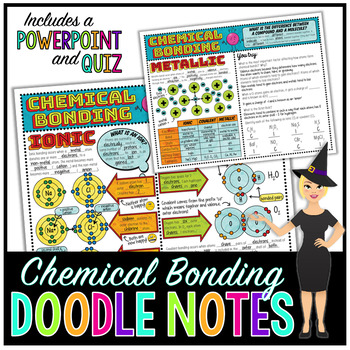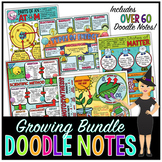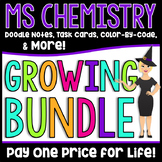Chemical Bonding Doodle Notes | Science Doodle Notes
- Zip
What educators are saying
Also included in
- These science graphic organizers include a range of topics from life science, physical science, earth & space science, chemistry, and general science.What does a growing bundle mean?Purchasing this growing bundle means that you save 20% on all current resources in the bundle, any updates to thePrice $259.99Original Price $358.82Save $98.83
- These science graphic organizers include a range of chemistry topics including atoms and elements, acids and bases, chemical and physical changes, chemical bonding, types of mixtures, types of reactions, rates of reactions, and more. Plus new doodle notes are being added!What does a growing bundle mPrice $59.99Original Price $77.38Save $17.39
- If you are looking for a one-stop shop for middle school chemistry resources, you came to the right place! This growing bundle offers a wide range of activities and topics that will make teaching middle school chemistry a breeze. I've also included my Scientific Method Doodle Notes as a bonus!What dPrice $147.00Original Price $184.50Save $37.50
Description
This science graphic organizer will aid students in identifying and defining ionic bonds, covalent bonds, and metallic bonds. Students will draw electron configurations that illustrate how each type of bond is formed. Also included is a "you try" section with questions for students to answer.
With what standard does this resource align?
This resource will aid students in moving towards mastery of the Next Generation Science Standard NGSS MS-PS1-2 and NGSS HS-PS1-2.
What are doodle notes?
Doodle notes are a visual aid that will increase student concept retention, focus, creativity, and engagement. Students will gain experience in synthesizing information and creating their own tangible connections in their notes.
What do I have to do?
These doodle notes are no prep! Print which version of the doodle notes is most appropriate for your students (easy differentiation!) and use my provided notes or your own. I have included a PowerPoint slide show that includes the answers to the fill-in-the-blank notes. I have also included a student quiz to easily assess student mastery of the doodle notes content.
How do I use doodle notes?
• Teacher led note taking
• Student led note taking
• Independent research or homework
What is included?
⭐ 1 Fill-in-the-blank doodle notes (2 pages)
⭐ 18 PowerPoint slides for the fill-in-the-blank notes
⭐ 1 Blank doodle notes for using your own notes (2 pages)
⭐ 1 Completed examples of the doodle note (2 pages)
⭐ 1 Student quiz with teacher key.
Want more Chemistry Doodle Notes?
Save 20% on my Chemistry Doodle Note Growing Bundle
Want even more Doodle Notes?
Save 20% on all my doodle notes with my Science Doodle Notes Growing Bundle
Connect with me
My Blog: www.themorehousemagic.com
Instagram: @themorehousemagic
Facebook: The Morehouse Magic
"Doodle Notes" is a trademarked term. Used with permission. Please visit www.doodlenotes.org for more information.








